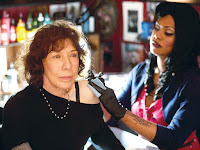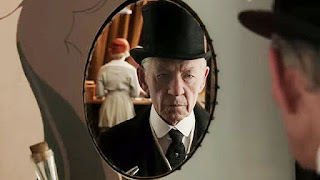Grandma features Lily Tomlin in a go for broke performance that continues her collaboration with writer-director Paul Weitz from Admission (2013). This is a more linear, classically structured story than that earlier movie with deeper undertones. It’s also far more assured, in part, because it’s Weitz’s original idea written for Tomlin. It meets the Bechdel/Wallace rule where two female characters, actually named, discuss something other than a man by offering a wealth of wonderful female actors intriguing roles. While a funny comedy about a tough subject, namely a grandmother trying to scrounge up the money for her granddaughter’s abortion, it’s also the realization of a joyous and sad life.
 |
| Tomlin and (Granddaughter) Julia Garner |
Tomlin plays Ellie Reid, a semi-retired writer-in-residence poet, who’s dealing with her grief over her partner’s death a year and a half earlier. She breaks up in a spat with her current girilfriend, who mistakenly thought that their relationship was more serious than it turned out to be. Judy Greer is both sweet and hilarious in the part. That’s when Sage, played by Julia Garner, shows up with what she needs from Grandma.
 |
| Tomlin with Hardin |
Both women want to avoid the girl’s mother Judy (Marcia Gay Harden) because she’s frighteningly driven and judgmental. (She’s also right as it turns out). All three look as if they’re related through their physical gestures. Tomlin seems ageless because she moves beautifully and she immediately connects to her character’s emotions and can pull in the viewer. She does everything with abandon, whether being cruel, kind, protective, or desperate. Harden, a great actress, does wonders with what could have been a stereotypical role. There’s a sense of historic conflict in her relationship with her mother. Garner seems wistful and even silly at the beginning, but through cautious discretion, she develops the steel that has been passed down from her female forebears. Significantly, all but one of the primary characters is intelligent. The selfish dope gets his come-uppance and it’s simultaneously funny and frightening.
 |
| Driving Around LA |
In trying to avoid Judy, Ellie and Sage initiate various episodes around Los Angeles that offer snapshots of Grandma’s life over fifty years, while the clock ticks down to an appointment that Sage arranged. With a picaresque, odyssey structure predicated on one action that must be completed within the day and an older protagonist giving life lessons to a younger protagonist through what she does, rather than what she says, Grandma should give students of Aristotle an absolute field day. Weitz never points any of this out; the camerawork presents everything in a casual, fly-on-the-wall manner that seems like it’s hand-held at the beginning, but becomes far more formal as the story moves further into
 |
Laverne Cox Gives
Lily Tomlin a Tattoo |
examining Ellie’s past. One thing I noted later was about generosity: the characters that gave money also gave in other ways and all of them are more complex than they initially appear, even if they’re only onscreen for five or ten minutes. Laverne Cox, Elizabeth Peña (in her last role), Sam Elliott (having a resurgence this year), Lauren Tom, the still luminous Judy Geeson, and even Colleen Camp in a two-line role inhabit characters that I wanted to know more about.
 |
| Elliot Confronts Tomlin |
The sweet Grandma, ‘Mama Vi,’ seen once in a photograph, but referred to positively by a number of characters, holds the emotional key to Ellie’s current state of mind and it’s her 1955 Dodge Royal that becomes a major presence since it seems to react emotionally (as well as mechanically) to what’s happening. (It’s Tomlin’s actual car). I felt that the conflict was about a late Silent Generationer, who came into her own through the upheavals of the ‘60s, trying to come to terms with her Generation X daughter, who’s more compassionate than she initially seems because she deals in a short-hand of fixing other people’s mistakes, and provide something for her Team Help (my term for the 2000 – 2018 births, sorry Douglas Coupland) granddaughter. It looks to be a generation that plays well in teams, but always needs help. Even though it seems to be an elegy to an idealistic age, Ellie is still in control of where she’ll go next in the final frames.
I hope that Tomlin and Weitz get the credit they deserve for this work. It stands as a bookend (naturally, since Ellie’s a poet and nowadays ‘people don’t read’) to The Late Show (1977), which we looked back at earlier this year, both because it’s a quest story set in Los Angeles that’s deceptively unassuming and also because it presents the hopes and frustrations of an era and generation that didn’t turn out quite the way they idealistically promised. Tomlin should have received a lead Oscar nomination then; she should receive another one for Grandma.































